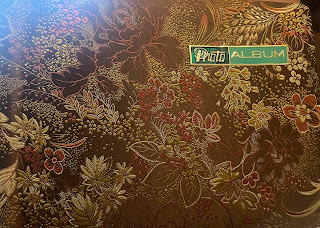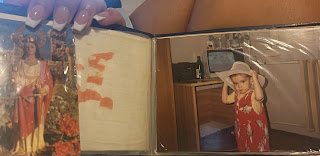Thursday, December 14, 2023
Documentary Critical Reflection
Wednesday, December 13, 2023
Editing + Post Production
After the production process, my group and I began to edit everything filmed. The first step into the editing process was reviewing all the footage. There were heaps of footage and it was important to identify which ones were important to use. After determining which clips were useful, we selected them and disregarded the rest. This was a difficult decision, as we loved a lot of the disregarded footage. For instance, there was supposed to be a whole segment of my mom's perspective during Susanas trips. However, when we were looking at the fluidity if this segment was inserted, it wouldn't have been as smooth. This is a choice I kind of regret, as I believe my mother's experience was just as important as my grandmothers.
Shortly after, we began with the long work first. This was the creation of the captions. This was the most tedious portion of editing, as we had to transcribe first and then translate. The transcribe process consisted of taking the audio said and converting it into written material. This was done to every clip thoroughly to make sure there were no errors. For the translation, a similar approach was taken but we had to pay much more attention to how the words translated. In Spanish, many things said when translated to English become distorted or the meaning changes. Since my grandma is Cuban, her Spanish is different from the traditional translator Spanish. This doesn't mean it's improper, it just means some things said in a different strand of Spanish can mean something different than what is translated, since the translator uses traditional Spanish.
After the transcribing and translating, we moved on to more basic editing. This includes lighting and audio. For lighting the light kit did a lot of the work. The mixture of the camera's quality. and the light kit made the shots look so clear and visually pleasing. There were just a few tweaks we had to manipulate to balance the warm tones and exposure. My grandmother's house is very bright and has more white lights than yellow. However, this was not the kind of lighting we believed was best suited for the doc. Since her voice is soft and she explains the situation calmly, we believed a more yellow tone would match better. Also, the elements of her house and mise-en-scene of what she was wearing would look better layered with warmer lighting, Clearly, we did this to almost every clip to make the visuals consistent. Collectively, the visual work went pretty steadily.
As for the audio, the microphones we were able to borrow were great help. The added so much clarity to the voice of the speakers. The auditory editing consisted of lots of editing tools on adobe premiere, mostly a heavy use of constant power since the audio was already pretty clear. This feature added smoother auditory transitions preventing harsh jumps from clip to clip.
More about the audio, I was in charge of finding the formfitting music to layer the audio with. I searched for a WHILEEE before finding the perfect non-copyright music to use. It was difficult to find music that was balanced with a relaxed tone with a little bit of sadness. Most of them were either just relaxing or side. One or the other. But luckily, since I wanted the doc to be successful, sound, and look amazing, I would not stop looking until I found the one. Which I did :) At first Mya and I thought the addition of relaxing/sad music was all that was necessary, but we soon realized we should add some motivational music as well. This is due to the fact that there are many instances throughout the film where Susana says things that're very moving and inspirational, especially towards the end. She states that anyone with the chance of migrating from an impoverished country should and how much its impacted her being one of those people. Relaxed music wouldn't really match the drive and determination Susana represents. SOO, I decided to get back on YouTube and looked more for motivational music that didn't sound like it was part of a marvel film. This would've thrown off the film's dynamic auditorily. But I found the right music for this part of the film :)
At this point, our doc was looking pretty professional but there were still some things missing. My teammate Mya Wolf made a proposal which I believe was extremely clever and helpful for the audience. This was the addition of the map visually showing the distance of Susanas journey from Cuba to Hungary to Miami fl, US. I believe this animation allowed the audience to see how much of a life shift her expedition made, due to the distance. The map was only one of the many forms of b-rolls we included. As mentioned previously, we recorded features around Susanas house that could embody some symbolism or link with the context. In the editing process, we had to review the video and its audio multiple times, to find the correct places to import the b-roll without hindering the videos visually. We also had to find the perfect time to import the b-roll, according to the things being said. For example, it is obvious we would use b-roll of her home to introduce the setting.
I believe in films not only is the title what intrigues me, but it also tells me what the film will be about. This meant we had to have a meaningful/suitable title. I tried to think of the perfect title. Some of them included:
- The life of an immigrant (WAYYY too broad)
- How I Changed My Life (just sounded iffy to me)
- The Turning Point (I liked this one, but it still wasn't right)
Tuesday, December 12, 2023
Production Process
A couple days before production, our teammate Mya had to rent out equipment from the local news station, BECON TV. The equipment consisted of
- 2 Sony Cameras
- 1 Tripod
- A lav mic
- A shotgun mic
- A Camera Handheld Stabilizer
- A light kit
Research and Planning Personal doc
There were various components that went into our documentaries production. One of the most important being the research aspect. Before beginning my researched, I remebered the main purpose of documentaries is to embody a "Slice of Life". This made me realize I had to choose a topic for my documentary, based on something socially significant and prevalent in the world today.
My first instinct was to think about reoccurring issues or events that go on around me. On a personal level, I thought about my family and things they've gone through and on a wider scale, I thought about the pressures of being a school student.
Student Approach- Over 4,000 students attend the high school I'm enrolled in, Cypress Bay High school. In my school, there is a wide array of difficult academic class options, including Aice and Ap. Almost all students are either forced to take these rigorous courses because of their parents or encouraged to take them, due to the competitiveness within the school. Moreover, Cypress Bay also offers a diverse range of clubs, such as the Drama club, Multicultural club, Pinkind, SGA, and many more. These are overlapped with all the extracurricular activities students typically are part of. As an active student, I sometimes struggle balancing my schedule and having time for everything without being overwhelmed. As I socialize with peers more, I realize I'm not the only one having a difficult time carrying out my day-to-day routine. It made me draw the conclusion that I'm only one amongst the many students finding it hard to strive in such a time consuming and work demanding environment. I really did like this idea and found formfitting interviewees; however, it didn't encompass the true issue I wanted to tackle and distribute to my audience.
SOOOO, I decided to dive even deeper into personal issues others can relate to, by focusing on my family. I chose to concentrate on my grandmother. This is because she is an extremely powerful woman with an even more powerful story. My grandmother, Susana Hernandez, is a super immigrant. This may sound bad, so let me put it into context. Susana was born in the impoverished area in Havanna Cuba. Her childhood was intense and tremendously difficult. The country had terrible food insecurity, leaving her and her family starved at times. When they weren't starving, the food sources were very limited which is difficult when part of such a big family. Not only was food limited, but also the chances of opportunity. Sadly, in Cuba, citizens don't have much of a future. When you live there, you're stuck, regardless of the conditions. My grandmother was one of the few that made it out of Cuba. She went from Cuba to Budapest Hungary, to the United States of America. THIS is what makes her a super immigrant. I believe her story was important to share, as there are a lot of immigrant stories that aren't shared enough. The whole journey she went through was unbelievably difficult. To show how much migrancy affects one's future, people must be educated, as well as exposed to the situation. I believe a documentary about this issue is the perfect way to grab people's attention visually and auditorily hearing the story.
Monday, December 11, 2023
New Year New Me
- biographical
- historical
- rockumentary
- nature
- expose
- and more.
- Typically shorter than full-length films
- Popular on streaming services
- Narrative format
- Archived footage
- Reliant on character/owner motivations
- Interviews progress story usually
- Hand held camera can convey realism
- etc.
- Cross cutting/parallel editing
- Specific lighting creates tone/realism/establish the pov
- Non-digetic sound (music and voiceovers)
- Sound effects create realism
- Selective editing to achieve purpose/to tell the story
- Montage
- Graphics + Infographics
- Music creates tone and develops the point of view
- Re-enactments
- Sometimes animated sequences (could be problematic)
American Promise was a documentary about the experiences of two middle class African Americans lives over the span of two years. The purpose was to see the progression of these children as they entered a prestigious private school on the upper East side of Manhattan. This school was known to have a mostly white population. In this film, Dalton high school recruited students of color from different parts of New York. Interviewees Idris and Seun were the lucky two best friends that were chosen. Throughout the documentary we see the children age, change, and mature. This isn't only visually seen by physical and auditory aspects of this film, but also from the shift in techniques used within the documentary. The most prominent shift was the use of interview types. When the children were younger, the director used the technique of direct interviews. This is because the children were not old enough to formulate a full response and to restate a complex question. This is why only the adults were seen given indirect interviews during this time. However, as they grew older, indirect interviews were the most frequently used interview type. Seeing this element progression took place helped gain ideas for my interviewee and how to approach my documentary.
Project Components
Here's the link for intertwined social media page! https://www.instagram.com/officialintertwined?igsh=MWo4NnhuaTRvazVmNg%3D%3D&utm_...
-
ROMANCEEE Mariana and I already knew our genre since we decided to do a short film. After speaking with our teacher, we realized our conce...
-
Here's the link for intertwined social media page! https://www.instagram.com/officialintertwined?igsh=MWo4NnhuaTRvazVmNg%3D%3D&utm_...
-
Decision Change So as I briefly mentioned in my past couple blogs, due to the sunsetting way quicker than we anticipated, our idea had to c...


















